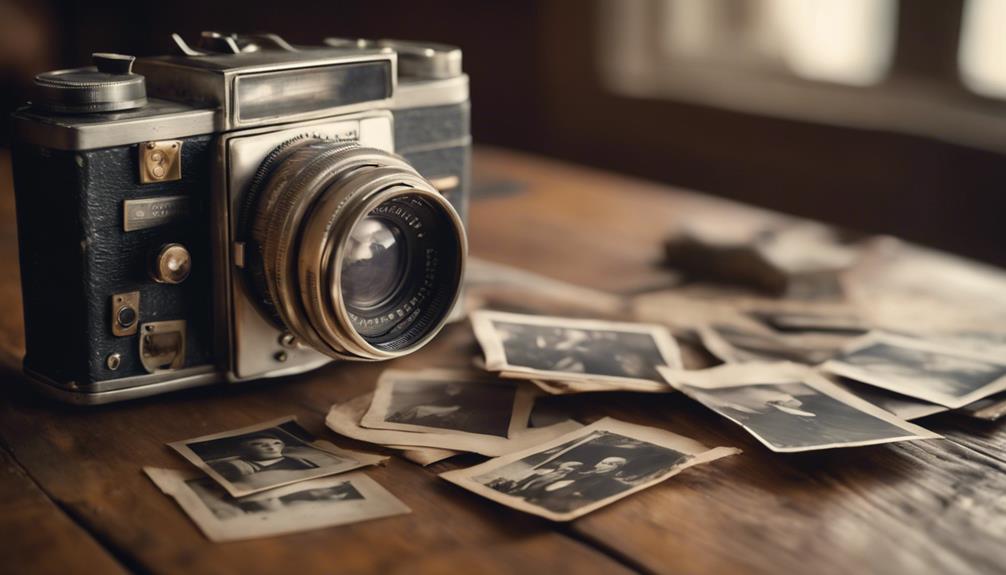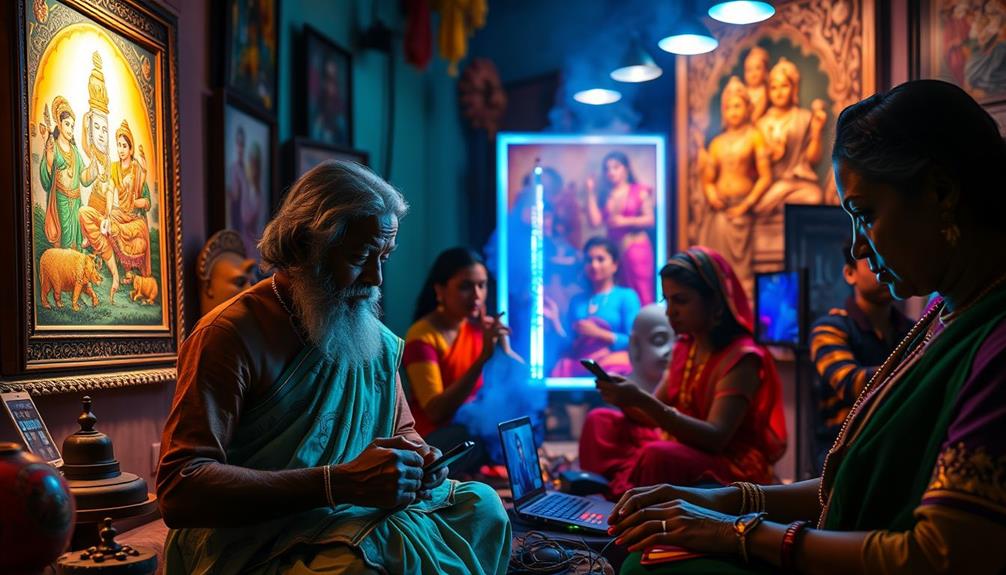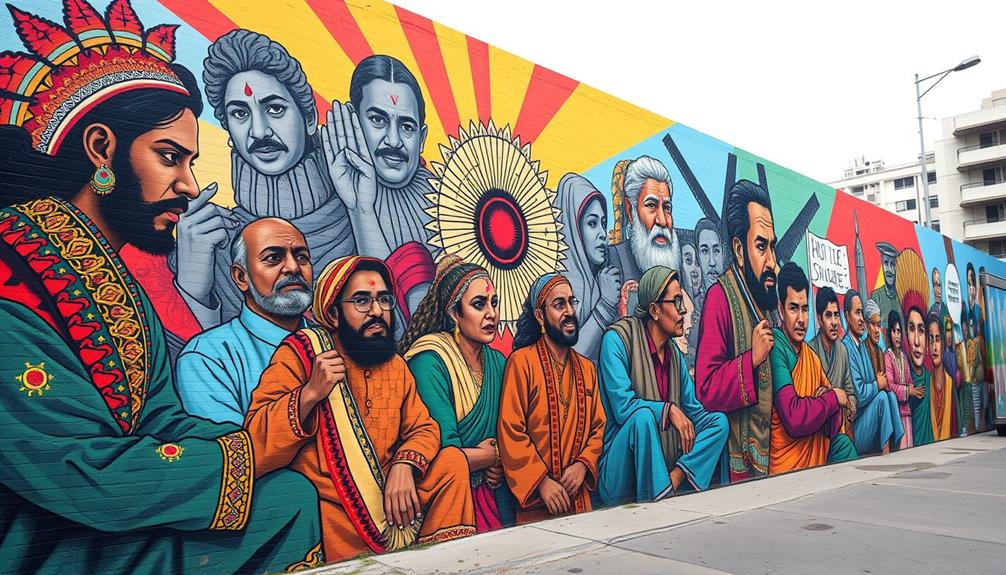This exceptional photography collection offers a unique perspective on history, challenging ingrained perceptions and revealing untold stories that have shaped our understanding of the past. Through iconic images, it showcases pivotal moments, cultural significance, and diverse viewpoints, providing a tangible link to bygone eras and historical figures. The photographs serve as invaluable tools in comprehending the complexities of our shared history and sparking critical engagement with the narratives that have defined our world. Exploring this collection will offer a transformative journey through time, encouraging a reimagining of historical events and a deeper connection to the complexities of our past.
Key Takeaways
- Reveals untold stories and hidden narratives through unique historical photographs.
- Provides diverse perspectives and insights into past events, cultures, and individuals.
- Challenges ingrained perspectives and offers a nuanced portrayal of historical figures and events.
- Acts as a catalyst for societal transformation, sparking empathy and inspiring action.
- Offers a fresh perspective on history, reimagining the past through powerful visual storytelling.
Impact of Iconic Photographs
Capturing pivotal moments in history, iconic photographs hold immense cultural significance and emotional resonance. These images have the power to transcend time and communicate the essence of impactful events.
For instance, Alfred Eisenstaedt's photograph 'The Kiss' encapsulates the end of World War II, symbolizing a moment of relief and hope for many. Dorothea Lange's 'Migrant Mother' from the Great Depression not only shed light on the harsh realities faced by many Americans but also sparked vital aid efforts for the struggling family depicted. Additionally, Joe Rosenthal's 'Raising the Flag on Iwo Jima' immortalizes the unity and triumph experienced by American forces during World War II.
Through the lens of photographers like Neil Armstrong and Steve McCurry, history unfolds in a single frame, allowing viewers to connect with the past on a profound level. These iconic photographs serve as visual records of our collective narrative, reminding us of where we've been and inspiring us to shape a better future.
Social Change Through Photography

Photography has played a pivotal role in capturing impactful visual narratives that showcase moments of societal change. Images like Dorothea Lange's 'Migrant Mother' and Lewis Hine's 'Power House Mechanic' haven't only raised awareness but also spurred action towards social justice.
Through these iconic photographs, photographers have been able to document injustices, challenge norms, and advocate for a more equitable society.
Impactful Visual Narratives
How can impactful visual narratives conveyed through photographs drive significant social change?
The history of photography is rich with examples of photographic images serving as catalysts for societal transformation. Iconic photographs like 'Migrant Mother' from the Great Depression era not only documented historical events but also shed light on pressing societal issues, mobilizing support and aid.
These visual narratives capture the essence of cultural movements, portraying the struggles and triumphs of various communities. Images such as 'Raising the Flag on Iwo Jima' symbolize unity, patriotism, and victory during times of conflict, resonating with audiences on a deep emotional level.
Through the power of impactful images, photographers have the ability to evoke empathy, spark conversations, and ultimately drive meaningful societal change. By harnessing the visual language of photography, these narratives can bridge gaps, challenge perceptions, and inspire action towards a more just and equitable society.
Capturing Moments of Change
Iconic photographs have a profound impact on society, shaping public perceptions and advocating for social change through visual storytelling.
American photographer Dorothea Lange's work during the Great Depression exemplifies how photography changed the narrative on poverty and human suffering, leading to increased awareness and government action.
Similarly, Gordon Parks' images documented the Civil Rights Movement, capturing moments of racial injustice and resilience that spurred conversations and pushed for societal transformation.
Through the lens of photography, pivotal moments like the Stonewall Riots have been immortalized, highlighting the fight for LGBTQ+ rights and equality.
These examples showcase how photography serves as a powerful tool to capture moments of change, challenge societal norms, and inspire action towards a more just and inclusive society.
Photographs not only document history but also actively participate in shaping it, making them invaluable assets in advocating for social justice and driving positive societal change.
Diverse Perspectives on History

Examining historical photography reveals a tapestry of diverse perspectives on past events, cultures, and individuals. Through these images, viewers are transported to different places and times, gaining valuable insights into the nuances of various eras and societies.
Photographs provide a unique window into history, capturing moments that shape our understanding of the past. They offer a nuanced portrayal of historical figures and events, shedding light on the complexities that have shaped our world.
Photography as a Historical Lens

Peering through the lens of historical photography, what insights into the past can be gleaned? Photography, as a historical lens, offers a unique perspective on bygone eras, providing glimpses into the lives, events, and cultures that have shaped our world.
Through the preservation of significant moments and individuals, historical photographs serve as invaluable tools in understanding the complexities of history. They not only document the past but also evoke emotions and foster connections to narratives long forgotten.
National Geographic, a renowned publication, has been instrumental in showcasing historical photography to a global audience, bringing attention to diverse stories and experiences captured through the lens. Additionally, the pioneering work of Nicéphore Niépce, credited with producing the world's first photograph, laid the foundation for the evolution of photography as an important medium for historical documentation.
Through these lenses, the past comes alive, offering a tangible link to the events and people who've shaped our world.
Rethinking Cultural Narratives

Historical photographs have the power to challenge ingrained perspectives and reveal hidden narratives within cultural histories. By shedding light on different viewpoints and untold stories, these images prompt a reevaluation of conventional understandings of the past.
Through the collection's diverse portrayal of historical events and societal norms, viewers are encouraged to engage critically with history, fostering a more nuanced and inclusive approach to cultural narratives.
Challenging Historical Perspectives
By presenting alternative viewpoints, historical photography reveals unconventional narratives, prompting a fresh perspective on cultural events. These images explore the depths of history, challenging our understanding of pivotal moments such as the Great Depression and the Civil War. Through the lens of the camera, they expose hidden truths and untold stories that reshape our perception of the past.
Historical photographs shed light on the human experiences during the Great Depression, capturing moments of resilience and struggle often disregarded in traditional accounts.
They offer glimpses of the Civil War beyond the battlefield, showcasing the impact on civilians, enslaved individuals, and marginalized communities whose voices have been muted by mainstream narratives.
Unveiling Hidden Narratives
Hidden narratives within the collection of historical photographs reveal alternative cultural understandings, prompting a reassessment of entrenched perspectives on the past.
Through the lens of these images, viewers are transported to New York during World War II, where untold stories and overlooked achievements come to light.
By exposing these hidden narratives, the collection challenges traditional historical accounts, offering a more expansive and inclusive view of the past.
These photographs not only shed light on the experiences of marginalized communities but also highlight the contributions of individuals who've been overlooked in mainstream narratives.
By showcasing diverse viewpoints and forgotten moments in history, the collection prompts a reexamination of preconceived notions and encourages a deeper understanding of the complexities of the past.
Through visual storytelling, these photographs provide a new lens through which to view history, inviting viewers to reconsider their perceptions and assumptions about the world around them.
Uncovering Untold Stories

Delving into photography collections uncovers untold stories that illuminate forgotten perspectives and narratives. Historical photographs offer a unique window at Le Gras into the past, providing a glimpse into moments that would otherwise remain unknown.
These images capture quiet moments that reveal the intricacies of daily life and the emotions of individuals who've long been overlooked in historical records. Through the lens of photography, hidden narratives come to light, shedding new insights on events and experiences that have been marginalized or forgotten.
Revealing hidden truths: Photography serves as a powerful tool for uncovering untold stories and challenging conventional historical narratives.
Amplifying marginalized voices: Historical photographs provide a platform for voices that have been silenced or ignored, offering a more inclusive perspective on the past.
Deepening understanding: By exploring these images, a deeper understanding of history emerges, enriching our knowledge of the complexities of the past.
Evolving Views on the Past

Photography has played a significant role in shaping evolving perspectives on the past, offering a dynamic visual lens through which to explore history. Historical images captured moments that were once only described in history books, providing a tangible connection to events and people of the past. These photographs, often referred to as windows to the past, have the power to evoke empathy and a deeper understanding of bygone eras.
Through the lens of a camera, common individuals who may have otherwise been forgotten are immortalized, their stories preserved for generations to come. These images aren't just snapshots frozen in time; they're essential for recording history accurately. They offer a unique glimpse into different eras, allowing us to appreciate and comprehend ancient societies in ways that history textbooks alone can't achieve.
Each photo ever taken serves as a vital piece in the puzzle of human history, shaping our views and understanding of the world that came before us.
Historical Context Through Images

Providing invaluable insights into the past, historical images captured through the lens of a camera offer a compelling window into different time periods and societies. Photography serves as a pivotal tool in conveying historical events, allowing individuals to connect with the past in a tangible and relatable manner. Through the lens of a camera, the following points become evident:
- Empathy and Connection: Photography enables viewers to empathize with historical events and connect emotionally to the experiences of people from different eras.
- Tangible Connection to Ancient Societies: Images captured through photography provide a tangible link to ancient societies, fostering a deeper understanding and appreciation of their cultures and ways of life.
- Accessible Records of the Past: Historical photographs act as accessible records of bygone eras, allowing individuals to engage with and learn from the diverse events and lifestyles of different time periods.
Photography, with its ability to immortalize both common individuals and significant historical events, plays a pivotal role in preserving the memory and impact of the past for future generations to explore and understand.
Reimagining History Through Photos

By exploring historical photos, one gains a fresh perspective on past events, enabling a reimagining of history through visual storytelling. Photography serves as a powerful tool to transport individuals to bygone eras, offering a glimpse into the lives, cultures, and pivotal moments that shaped our collective memory.
These images provide an immersive understanding of history, allowing viewers to see the world through the eyes of those who experienced it firsthand. Through the lens of historical photos, hidden stories, emotions, and intricate details emerge, shedding light on aspects that may have been overlooked in conventional historical narratives.
The ability of photography to capture fleeting moments in time fosters a deeper connection to the events and individuals that have influenced the course of history. By delving into the rich tapestry of historical photos, one can uncover a wealth of knowledge and insight, unraveling the complexities of the past through a visual medium that transcends time.
Frequently Asked Questions
How Does Photography Change History?
Photography changes history by providing a visual record of moments that shape our understanding of the past. Historic photographs offer a unique perspective on significant events and people, capturing details that words alone can't convey.
These images preserve cultural heritage and document societal changes over time. Through photography, societies and individuals' evolution throughout history are witnessed, creating a tangible link to our past that words alone can't replicate.
What Can Photography Tell Us About History?
Photography provides a unique lens through which to view history, offering tangible glimpses into past societies, events, and individuals. These visual records not only document historical moments but also convey emotions, cultural shifts, and societal norms of bygone eras.
Through photography, one can witness the evolution of fashion, architecture, technology, and societal structures, gaining a deeper understanding of how these elements have shaped the world we live in today.
How Can Photography Change What We See?
Photography alters perspectives by offering unique visual insights into historical events. Through images, viewers can experience the past in a more vivid and personal manner.
Photography transforms how we interpret historical figures and moments by providing a tangible connection to the past. It allows for a deeper understanding and emotional connection to history, shaping our perception of the world and the people who've shaped it.
How Did Photography Affect American History?
Photography profoundly impacted American history by providing a visual narrative of key events and societal issues.
Photographs like Dorothea Lange's Great Depression images shed light on social struggles, while iconic shots such as the Iwo Jima flag-raising symbolized patriotism during WWII.
Documenting industrialization, photographers like Lewis Hine raised awareness about labor conditions.
These images, preserved in archives like the Smithsonian American Art Museum, continue to shape our understanding of the past.
Conclusion
To sum up, this photography collection serves as a powerful time machine, transporting viewers to different eras and shedding light on untold stories.
Like a kaleidoscope of the past, each image reveals a unique perspective that challenges conventional narratives and invites us to rethink history.
Through the lens of these photographs, we're able to see the world in a new light, gaining a deeper understanding of the complexities that have shaped our past and present.









